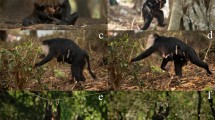Abstract
A group of six masked titi monkeys was studied at the Sooretama Biological Reserve, Espírito Santo, Brazil. The family group consisted of adult male and female, three juvenile-subadult offspring, and an infant carried by the father. Two patterns of activity were identified: one in which two major feeding peaks were separated by a single long rest period and a relatively long travel distance between the two major feeding sites; and a second in which three major feeding peaks were separated by rest periods and travel was more evenly dispersed throughout the day.Callicebus personatus was similar toC. moloch in the folivorous supplementation of its frugivorous diet, and in having marked daily peaks in feeding and resting activities.C. personatus was similar toC. torquatus in the location of sleeping position on a large open bough, and the habit of calling from well within the territorial boundary. All three species are known to live in monogamous family units with parental care by the adult male, defend territories with loud intergroup vocalizations, and feed primarily upon a small number of widely dispersed fruits.
Similar content being viewed by others
References
Clutton-Brock, T. H., 1977. Some aspects of intraspecific variation in feeding and ranging behaviour in primates. In:Primate Ecology,T. H. Clutton-Brock (ed.), Academic Press, N.Y., pp. 539–556.
Easley, S. P., 1982. Ecology and Behavior ofCallicebus torquatus, Cebidae, Primates. Unpublished Ph.D. dissertation, Washington Univ., St. Louis, Missouri.
Hershkovitz, P., 1963. A systematic and zoogeographic account of the monkeys of the genusCallicebus (Cebidae) of the Amazonas and Orinoco River Basins.Mammalia, 27: 1–79.
Kinzey, W. G., 1977a. Diet and feeding behavior inCallicebus torquatus. In:Primate Ecology,T. H. Clutton-Brock (ed.), Academic Press, N.Y., pp. 127–151.
————, 1977b. Positional behavior and ecology inCallicebus torquatus.Ybk. Phys. Anthropol., 20: 468–480.
————, 1978. Feeding behaviour and molar features in two species of titi monkey. In:Recent Advances in Primatology, Vol. 1, Behaviour,D. J. Chivers &J. Herbert (eds.), Academic Press, London, pp. 373–385.
————, 1981. The titi monkeys, GenusCallicebus. In:Ecology and Behavior of Neotropical Primates,A. F. Coimbra-Filho &R. A. Mittermeier (eds.), Brasilian Academy of Sciences, Rio de Janeiro, pp. 241–276.
————, 1982. Distribution of primates and forest refuges. In:Biological Diversification in the Tropics,G. T. Prance (ed.), Columbia Univ. Press, N.Y., pp. 455–482.
———— &J. G. Robinson, 1983. Intergroup loud calls, range size and spacing inCallicebus torquatus.Amer. J. Phys. Anthropol., 60: 539–544.
————,A. L. Rosenberger, P. S. Heisler, D. Prowse &J. Trilling, 1977. A preliminary field investigation of the yellow handed titi monkey,Callicebus torquatus torquatus, in Northern Peru.Primates, 18: 159–181.
Lund, P. W., 1843. Bemerkungen über die jetzt lebende Brasilianische Thierwelt in den obigen Abhandlungen.Oken, Isis, col. 738–760.
Mason, W. A., 1966. Social organization of the South American monkey,Callicebus moloch: a preliminary report.Tulane Studies in Zool., 13: 23–28.
————, 1968. Use of space byCallicebus groups. In:Primates, Studies in Adaptation and Variability,P. C. Jay (ed.), Holt, Rinehart & Winston, N.Y., pp. 200–216.
Robinson, J. G., 1979a. Vocal regulation of use of space by groups of titi monkeysCallicebus moloch.Behav. Ecol. Sociobiol., 5: 1–15.
————, 1979b. An analysis of the organization of vocal communication in the titi monkeyCallicebus moloch.Z. Tierpsychol., 49: 381–405.
Ruschi, A., 1964. Macacos do estado do Espírito Santo.Bol. Mus. biol., Prof. Mello Leitão (Santa Teresa), 23A: 1–23.
Waser, P., 1977. Feeding, ranging and group size in the mangabeyCercocebus albigena. In:Primate Ecology,T. H. Clutton-Brock (ed.), Academic Press, N.Y., pp. 183–222.
Wied-Neuwied, Maximilian Prinz, 1820–1821. Reise nach Brasilien in den Jahren 1815 bis 1817, 2 vols. H. L. Brönner, Frankfurt a. M.
Wright, P. C., in press. Adaptive advantages of nocturnality inAotus. Amer. J. Phys. Anthropol.
Author information
Authors and Affiliations
About this article
Cite this article
Kinzey, W.G., Becker, M. Activity pattern of the masked titi monkey,Callicebus personatus . Primates 24, 337–343 (1983). https://doi.org/10.1007/BF02381979
Received:
Accepted:
Issue Date:
DOI: https://doi.org/10.1007/BF02381979




